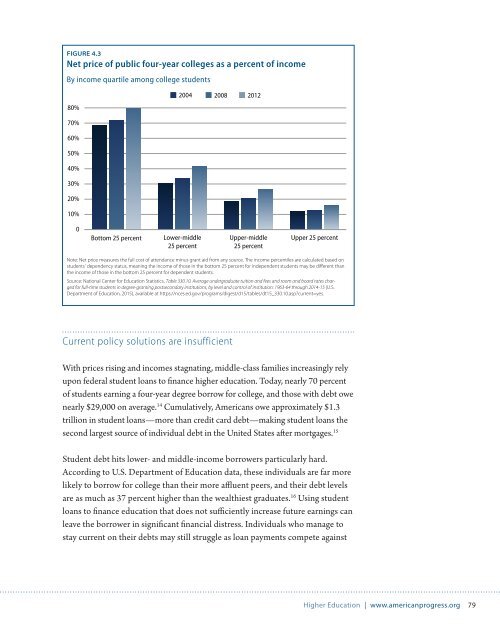AGENCY/PHOTOGRAPHER
RaisingWagesRebuildingWealth
RaisingWagesRebuildingWealth
You also want an ePaper? Increase the reach of your titles
YUMPU automatically turns print PDFs into web optimized ePapers that Google loves.
FIGURE 4.3<br />
Net price of public four-year colleges as a percent of income<br />
By income quartile among college students<br />
80%<br />
2004 2008 2012<br />
70%<br />
60%<br />
50%<br />
40%<br />
30%<br />
20%<br />
10%<br />
0<br />
Bottom 25 percent<br />
Lower-middle<br />
25 percent<br />
Upper-middle<br />
25 percent<br />
Upper 25 percent<br />
Note: Net price measures the full cost of attendance minus grant aid from any source. The income percentiles are calculated based on<br />
students' dependency status, meaning the income of those in the bottom 25 percent for independent students may be different than<br />
the income of those in the bottom 25 percent for dependent students.<br />
Source: National Center for Education Statistics, Table 330.10. Average undergraduate tuition and fees and room and board rates charged<br />
for full-time students in degree-granting postsecondary institutions, by level and control of institution: 1963-64 through 2014-15 (U.S.<br />
Department of Education, 2015), available at https://nces.ed.gov/programs/digest/d15/tables/dt15_330.10.asp?current=yes.<br />
Current policy solutions are insufficient<br />
With prices rising and incomes stagnating, middle-class families increasingly rely<br />
upon federal student loans to finance higher education. Today, nearly 70 percent<br />
of students earning a four-year degree borrow for college, and those with debt owe<br />
nearly $29,000 on average. 14 Cumulatively, Americans owe approximately $1.3<br />
trillion in student loans—more than credit card debt—making student loans the<br />
second largest source of individual debt in the United States after mortgages. 15<br />
Student debt hits lower- and middle-income borrowers particularly hard.<br />
According to U.S. Department of Education data, these individuals are far more<br />
likely to borrow for college than their more affluent peers, and their debt levels<br />
are as much as 37 percent higher than the wealthiest graduates. 16 Using student<br />
loans to finance education that does not sufficiently increase future earnings can<br />
leave the borrower in significant financial distress. Individuals who manage to<br />
stay current on their debts may still struggle as loan payments compete against<br />
Higher Education | www.americanprogress.org 79


